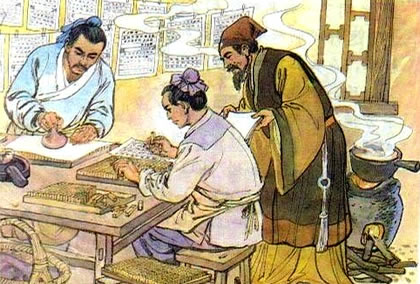 |
| Printing Invention in China |
Paper and printing were both invented by the Chinese, with immense importance for the advancement of civilization in China and worldwide. Papermaking was invented in China around 100 c.e. The technology spread to the Muslim world in the eighth century by Chinese papermakers taken prisoners by Muslims in Central Asia; it spread to Spain by the Moors in the 12th century.
In 175 leaders of the Han dynasty (202 b.c.e.–220 c.e.) ordered that the Confucian classics be engraved on stone slabs to ensure their correct transmission. Scholars began to make rubbings from the stones with paper; copies made from rubbings were the precursors of block printing.
The popularity of Buddhism in China in the post-Han centuries created a demand for printed charms, holy pictures, and religious texts by the pious. The earliest printed books were made during the Tang (T’ang) dynasty (618–909). They were Buddhist texts carved onto pear-wood blocks, which were inked with India ink (made with soot from oil lamps).
 |
A sheet of paper was pressed over the block, which became a printed page. Some Tang kala printed texts (including a copy of the Diamond Sutra printed in 868) have been preserved in the caves in Dunhuang (Tun-huang), an important early center of Chinese Buddhism in north-western China.
Feng Dao (Feng Tao) is regarded in China as the publisher of the first books. He lived in the 10th century in Chengdu (Chengtu) in Sichuan (Szechwan) province, then a center of the printing industry.
He received a commission from the government and spent 21 years between 932 and 953 editing and printing a set of the Confucian classics. Since Confucianism was China’s state ideology and school curriculum and the state examinations were based on the Confucian canons, it was important for the government to issue a definitive text.
The technology quickly spread to Korea and Japan. Private printers were soon printing histories, Buddhist and Daoist (Taoist) treatises, and other works, using both wood and metal blocks. Under the Song (Sung) dynasty (960–1279) Chinese printed books reached their high point.
The next step in printing was development of the movable type, which a contemporary work credits to a man named Bi Sheng (Pi Sheng), who experimented with movable fonts made of iron during the 1040s. This invention made books more available and cheaper.
In 970 the printing press in China began to print money, the first country to use paper currency. Paper currency was common during the following Yuan dynasty (1279–1368), and it was one of the marvels Marco Polo described in the book of his travels.
Papermaking spread from China westward via the Silk Road, to the Arabs in the eighth century, and the Arabs spread the technology to Europe. The first paper mill in Europe was built in France in 1189. Printing also spread westward from China during the 13th century when China met Europe under the Mongol empire.
EmoticonEmoticon